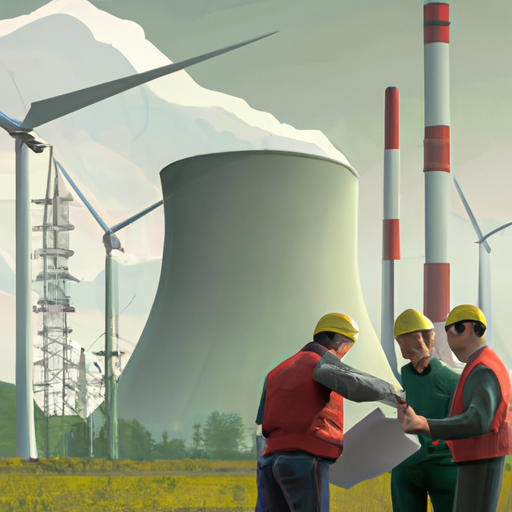Despite the current turmoil resulting from the unanticipated aggression from Russia, Ukraine aims to pave the way to a fossil-free future. The country is leaning towards a robust strategy that involves harnessing its nuclear facilities, wind, and solar resources. In this vein, Ukraine has embarked on a colossal wind power project at the infamous 1986 Chernobyl nuclear disaster site, known as Chornobyl in Ukrainian.
Russia’s Failed Power Grab and Its Consequences
Russian President Vladimir Putin’s intent to usurp complete control over Ukraine via a swift assault on its capital, Kyiv, fell short of his expectations. His strategy was to get hold of the rich fossil energy reserves that come with the control of Kyiv. Various unintended implications have arisen due to this failed maneuver, initiating new global discourses.
Europe Accelerates Towards Alternative Energy Sources
One such implication is Europe’s hastened quest to substitute Russian gas with alternative energy sources. This transition denotes a shift in the global gas supply chain in the short term, resulting from Russia’s invasion. Consequently, this has underlined the criticality of local, regional, and decentralized energy resources in terms of long-term resurgence and security, thus favoring renewable energy.
How Chernobyl’s Brownfield Serves the Green Energy Purpose
Renewable energy initiatives also posit a chance to reuse brownfield locations. A case in point is the new wind power plant that Ukraine plans to set up within the Exclusion Zone, which is a 30-kilometer radius surrounding the Chernobyl disaster site.
The Chernobyl Exclusion Zone to Recovery Zone Transformation Project
As per reports by The Odessa Journal, Ukraine’s wind power project is a part of a pre-war scheme to convert the Exclusion Zone into a Recovery Zone, which will contribute to energy autonomy, promote green technologies, generate revenue, attract investments, and create job opportunities.
This transformational project is managed by the Ministry of Environmental Protection and Natural Resources of Ukraine and the State Agency of Ukraine for the Management of the Exclusion Zone. They collaborate with Ukrenergo, the Ukrainian transmission systems operator, and German firm NOTUS Energy.
An Ecological Makeover for the Exclusion Zone
First Deputy Minister of Environmental Protection and Natural Resources, Alexander Krasnolutsky, confirms the planned ecological overhaul for the Exclusion Zone. He believes that this project will serve as a positive demonstration for international investors, proving the viability of the zone for eco-friendly technological solutions.
The New Wind Farm: A Sustainable Powerhouse?
With its substantial capacity of 1,000 megawatts, the new wind farm by NOTUS Energy has the potential to generate electricity equivalent to the consumption of 800,000 households. This could potentially create a resilient energy blueprint for Ukraine, thereby enhancing energy independence and decentralization.
Ukraine’s Journey Towards Sustainable Energy Resilience
While US military support for Ukraine has drawn significant media attention, sustainability support has been largely overlooked. Nonetheless, Russia’s tactic of targeting energy infrastructure and civilian zones underlines the importance of establishing sustainable, secure, and resilient energy systems.
How the US is Contributing to Ukraine’s Renewable Energy Endeavors
The US Department of Energy has been utilizing its National Renewable Energy Laboratory to support the energy program of the United States Agency for International Development. This program aims to help Ukraine lessen its nuclear energy dependency and introduce wind power, solar power, and other renewables into the power grid.
Possible Threats and Challenges
However, despite the current energy initiatives, a working paper posted by Oxford University’s Smith School of Enterprise and the Environment raises concerns about recovery plans not matching the green aspirations. Possible cross-purposes in the proposals also pose a threat to the green recovery of Ukraine.
Despite these challenges, the aim remains to leverage Ukraine’s renewable resources, including biomethane, solar and wind power, to cater to European energy markets and beyond. All these green initiatives set a trailblazing path towards a global transformation and highlight the country’s potential to contribute a substantial share in the world’s green supply chains.
Conclusion
As per Razom, Campaigns Manager at the Ukrainian organization Razom We Stand, “The post-war recovery of Ukraine provides a unique opportunity to direct finance towards low-GHG and climate-resilient development, creating the foundation for a green economy and setting a positive example for the rest of the world.”
It remains to be seen how much the US will support Ukraine’s green recovery. With the 2024 presidential election looming, Putin’s support network—including former president Trump and Republican party leadership—may influence the course of US policy regarding Ukraine.

























